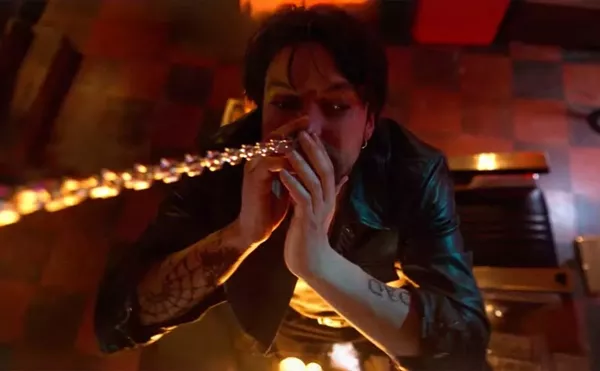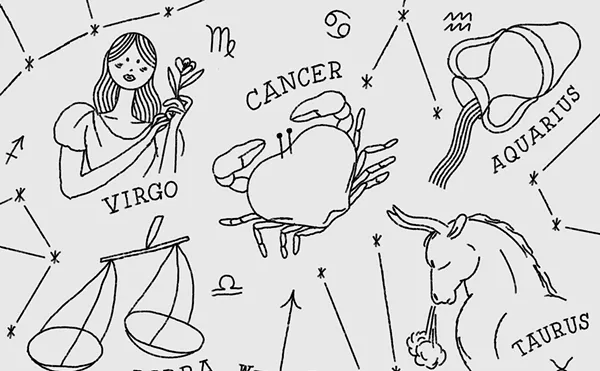
Audio By Carbonatix
[
{
"name": "GPT - Leaderboard - Inline - Content",
"component": "35519556",
"insertPoint": "5th",
"startingPoint": "3",
"requiredCountToDisplay": "3",
"maxInsertions": 100,
"adList": [
{
"adPreset": "LeaderboardInline"
}
]
}
]
It’s summer and in the mystic land of art galleries — where the dark gods of mortality, immortality and economics struggle for supremacy, and where artists thrive or perish — two spaces are showing their pantheons. Revolution and Lemberg Galleries offer glimpses of the staying power of certain artists and the future possibilities of others.
In the distant corner of Revolution’s front room is a monitor from which squirts a kind of alternative techno-drone. Awkward cameo images of mostly young men riding New York’s “L” train bounce on the screen in time with indie group Revlon 9’s seductive tune “I Want You.” The viewer has a moment to engage the chance-encountered figures before a sign flashes across them that says either “Yes,” “No” or “Maybe.” The sound track’s message quickly helps you realize that you’re watching a video survey of the desirability of these guys on the subway.
Yes (pictured) is a four-minute-long video that can easily be watched many times without wearying. First, you try guessing which guys are or are not desirable (if, indeed, that’s what is being judged) before New York artist Abbey Williams labels them with a sign across their face or body. If you’re a guy, you might wonder if you’d have made the cut or not. One disappointment is that the primary criteria for the guys getting labeled are youth and some kind of vague American wholesomeness. Any male with any sense of maturity and/or imagination, let alone a non-European cultural background, usually isn’t even looked at or is quickly given the “No.” While Williams’ Yes is specifically a self-effacing parody of the fickle nuances of desire and commodity fetishism, it’s also an extraordinarily conscious act of art-making.
Yes understands the process of making meaning through the delicate romancing and finessing of its own system of signs. It’s an exhilarating act of articulation that delivers the whole package: music, visual rhythm, social landscape, urban profile, a narrative of sexual confession, a tour-de-force lesson in colonial consumer voyeurism and the aesthetic ideology that goes with a Bard master’s degree in fine arts. (Make sure you read her “artist’s statement.”)
Williams’ video sits nicely as the centerpiece of “Look Out,” Revolution’s summer exhibition that features five video works as well as photography and painting by 12 artists, while generally exploring poignant social and political themes. Yes harmonizes well with Bradley McCallum and Jacqueline Tarry’s collaborative video and photography project that explores Seattle’s homeless street culture — with video portraits of drug-addicted youth that memorialize friends of the artists who have died on the streets.
Besides revisiting previously seen work by Revolution’s stable, such as Inigo Manglano-Ovalle’s provocatively annoying video installation, WooferWoofer!, the exhibition introduces Chicago artist Siebren Versteeg’s Rocket, a computer-programmed video that explores concepts of infinity and social reality. On a video monitor, we watch real time elapse on an on-screen digital clock as a composite image of a rocket accelerates toward the infinite heavens without the least sense of progress.
A couple doors down Woodward Avenue, Lemberg Gallery also has a summer lineup that introduces a couple of extraordinary works by its regulars, as well as the paintings of an exciting young artist.
Well-known Detroit artist and Lemberg staple Tom Phardel’s Double Circle (pictured) signifies a new trajectory in his work. As usual, this painted-steel wall sculpture is elegantly crafted, but Phardel has upped the ante and given us a new level of ideas and a new body of references to deal with. In the shape of a shield containing twin circles, inside of which provocative forms are centered, the sculpture is a graphic exploration of sexual iconography. Beyond that, it looks like a classic wooden prototype for creating machine parts. In this elegantly geometrical work, the metaphoric possibilities of the interchangeability of machine and body parts are understated and astute.
Another Lemberg regular, Susan Goethel Campbell, uses geometric mats as overlays to mask her astonishing “brushed ink on paper” images of clouds while transforming them into rigorous graphic statements. The combination of the allusive, ever-changing clouds with hard-edged graphics portends a new direction in her work and is a smart revisiting of modernism’s celebration of nature.
Finally Megan McGinnis’ four, small, domestic paintings are a great example of the new hybrid forms that are emerging from young painters. A recent graduate of the Cranbrook Academy of Art, McGinnis uses photographic-like painting techniques, such as X-rays and solarization, to push banal domestic realism into the dramatic new realms of medical or psychic metaphors.
Both Revolution and Lemberg have assembled group exhibitions that represent the galleries’ ideals with strong socially and artistically significant work — and they’re well worth a summer afternoon of meditation.
“Look Out,” through Aug. 2 at Revolution (23257 Woodward Ave., Ferndale – 248-541-3444), also includes work by Conrad Bakker, Randy Bolton, Jen Durbin, Howard Kottler, Kirsten Mosher, Stephen Tourlentes and Peter Williams.
Other artists showing through Aug. 9 at Lemberg Gallery (23241 Woodward Ave., Ferndale – 248-591-6623) include Jane Dickson, Robert Gniewek, Janet Hamrick, Jonathan Lasker, Stephen Magsig, Sharon Que, Julian Schnabel, Joe Smith and Matthew Penkala.
Glen Mannisto writes about art for Metro Times. E-mail him at letters@metrotimes.com




